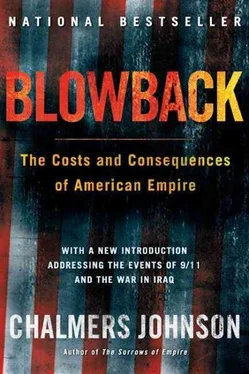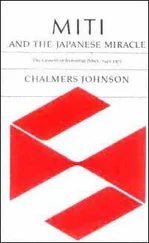Chalmers Johnson - Blowback, Second Edition - The Costs and Consequences of American Empire
Здесь есть возможность читать онлайн «Chalmers Johnson - Blowback, Second Edition - The Costs and Consequences of American Empire» весь текст электронной книги совершенно бесплатно (целиком полную версию без сокращений). В некоторых случаях можно слушать аудио, скачать через торрент в формате fb2 и присутствует краткое содержание. Год выпуска: 0101, ISBN: 0101, Издательство: Macmillan, Жанр: Старинная литература, на английском языке. Описание произведения, (предисловие) а так же отзывы посетителей доступны на портале библиотеки ЛибКат.
- Название:Blowback, Second Edition: The Costs and Consequences of American Empire
- Автор:
- Издательство:Macmillan
- Жанр:
- Год:0101
- ISBN:9780805075595
- Рейтинг книги:5 / 5. Голосов: 1
-
Избранное:Добавить в избранное
- Отзывы:
-
Ваша оценка:
- 100
- 1
- 2
- 3
- 4
- 5
Blowback, Second Edition: The Costs and Consequences of American Empire: краткое содержание, описание и аннотация
Предлагаем к чтению аннотацию, описание, краткое содержание или предисловие (зависит от того, что написал сам автор книги «Blowback, Second Edition: The Costs and Consequences of American Empire»). Если вы не нашли необходимую информацию о книге — напишите в комментариях, мы постараемся отыскать её.
Blowback, Second Edition: The Costs and Consequences of American Empire — читать онлайн бесплатно полную книгу (весь текст) целиком
Ниже представлен текст книги, разбитый по страницам. Система сохранения места последней прочитанной страницы, позволяет с удобством читать онлайн бесплатно книгу «Blowback, Second Edition: The Costs and Consequences of American Empire», без необходимости каждый раз заново искать на чём Вы остановились. Поставьте закладку, и сможете в любой момент перейти на страницу, на которой закончили чтение.
Интервал:
Закладка:
Even should a U.S. president and Congress one day wake up to their constitutional duties and reassert authority over the Department of Defense, that still might not bring JCET and similar programs under control. The Pentagon’s most recent route around accountability is “privatization” of its training activities. As investigative journalist Ken Silverstein has written, “With little public knowledge or debate, the government has been dispatching private companies—most of them with tight links to the Pentagon and staffed by retired armed forces personnel—to provide military and police training to America’s foreign allies.” 26The companies involved are generally associated with the Department of Defense’s Special Operations Command, which has replaced the CIA’s Directorate of Operations as the main American sponsor of covert action in other countries. Nonetheless, these are privately contracted mercenaries who, by their nature, are not directly responsible to the military chain of command. In many cases, these private companies have been formed by retired special forces personnel seeking to market their military training to foreign governments, regardless of the policies of the Defense Department.
One reason privatization appeals to the Pentagon is that whatever these companies do becomes “proprietary information.” The Pentagon does not even have to classify it; and as private property, information on the activities of such companies is exempt from the Freedom of Information Act. Given the extreme legalism of American political culture, this is sufficient to shield such companies from public scrutiny, although it would probably not protect them from the new international criminal court. Private companies are at present training the armies of Croatia and Saudi Arabia and are active in Honduras, Peru, and many other Latin American countries. Such firms also purchase weaponry from former Soviet states for distribution to groups that the U.S. government may want to arm without being accused of doing so, such as guerrillas fighting for Bosnia and in Kosovo.
In addition to the Department of Defense’s JCET operations, both public and private, its arms sales are a vital component of stealth imperialism. By several orders of magnitude the United States maintains the world’s largest military establishment and is the world’s biggest arms exporter. According to 1995 figures released by the U.S. Arms Control and Disarmament Agency (whose very name is an Orwellian misnomer and which, in 1998, was absorbed by the State Department), the world spent $864 billion on military forces. Of this amount, the United States accounted for $278 billion, or 32 percent, some 3.7 times more than the then second-ranked country, Russia. 27The most dramatic cuts in military spending since 1987, the all-time peak year, when $1.36 trillion worth of arms passed from manufacturers to buyers, have come from Russia and other states of the former Soviet Union. The Stockholm International Peace Research Institute (SIPRI) reports that in 1997 the U.S. share of global deliveries of major conventional weapons, worth about $740 billion, had grown to 43 percent whereas Russia’s share was 14 percent. 28
In 1997, total worldwide military and arms spending was approximately one-third lower than ten years ago, at the end of the Cold War. Nonetheless, in addition to being the world leader in arms transfers, the United States continues to dominate the development of military technology. According to SIPRI, the U.S. military research and development budget was more than seven times that of second-place France. In 1997, SIPRI found that the world spent $58 billion on military R&D, of which the United States spent $37 billion. In terms of overall national military spending, the Pentagon’s most recent Quadrennial Defense Review, concluded in May 1997, envisaged defense budgets in the range of $250-260 billion until the end of time—an amount vastly greater than anything that might be spent by any conceivable combination of adversaries. The defense budget for the year 2000 was $267.2 billion, plus augmentations in order to pay for the Kosovo war.
Together with NATO, Japan, South Korea, and Israel, the United States accounts for 80 percent of the world’s total military spending. In 1995, the United States alone outspent Russia, China, Iraq, Syria, Iran, North Korea, Libya, and Cuba combined, by a ratio of two to one; with its allies, it outstripped all potential adversaries by a ratio of four to one. If the comparison is restricted to only those countries considered regional threats by the Pentagon—the “rogue states” of Iraq, Syria, Iran, North Korea, Libya, and Cuba—the United States outspent them twenty-two to one.
Interestingly enough, maintaining access to Persian Gulf oil requires about $50 billion of the annual U.S. defense budget, including maintenance of one or more carrier task forces there, protecting sea lanes, and keeping large air forces in readiness in the area. But the oil we import from the Persian Gulf costs only a fifth that amount, about $11 billion per annum. Middle Eastern oil accounts for 10 percent of U.S. consumption, 25 percent of Europe’s, and half of that of Japan, which contributes in inverse proportion to maintaining a G-7 military presence there. It is not that Europe and Japan are incapable of securing their own oil supplies through commercial treaties, diplomacy, or military activity, but that America’s global hegemony makes it unnecessary for them to do so.
One of the things this huge military establishment also does is sell arms to other countries, making the Pentagon a critical economic agency of the United States government. Militarily oriented products account for about a quarter of the total U.S. gross domestic product. The government employs some 6,500 people just to coordinate and administer its arms sales program in conjunction with senior officials at American embassies around the world, who spend most of their “diplomatic” careers working as arms salesmen. The Arms Export Control Act requires that the executive branch notify Congress of foreign military and construction sales directly negotiated by the Pentagon. Commercial sales valued at $14 million or more negotiated by the arms industry must also be reported. Using official Pentagon statistics, between 1990 and 1996 the combination of the three categories amounted to $97,836,821,000. From this nearly $100 billion figure must be subtracted the $3 billion a year the government offers its foreign customers to help subsidize arms purchases from the United States.
According to the Stockholm International Peace Research Institute, the five leading arms suppliers for the period 1993 through 1997 were the United States, Russia, England, France, and Germany, though total American sales were some $14 billion greater than those of the other four combined. SIPRI has found that the five leading arms purchasers for that period were Saudi Arabia, Taiwan, Turkey, Egypt, and South Korea, each of which spent between $5 billion and $10 billion on arms over this five-year period. 29Japan was the second-biggest purchaser of high-tech weapons. All the leading purchasers were close American allies or clients.
Both the United States government and the world’s arms dealers claim that the arms trade has declined since 1987, the benchmark year for the Cold War. However, this “decline” is based almost entirely on declining arms sales by the former Soviet bloc—and it is likely that the 1987 estimates of arms sales by the former Soviet Union were as inflated as the estimates of, for example, the Soviet naval threat during the 1980s. American arms sales in any case have actually increased in the years since the Cold War ended. By 1995, according to its own Arms Control and Disarmament Agency, the United States was the source of 49 percent of global arms exports. It shipped arms of various types to some 140 countries, 90 percent of which were either not democracies or were human rights abusers.
Читать дальшеИнтервал:
Закладка:
Похожие книги на «Blowback, Second Edition: The Costs and Consequences of American Empire»
Представляем Вашему вниманию похожие книги на «Blowback, Second Edition: The Costs and Consequences of American Empire» списком для выбора. Мы отобрали схожую по названию и смыслу литературу в надежде предоставить читателям больше вариантов отыскать новые, интересные, ещё непрочитанные произведения.
Обсуждение, отзывы о книге «Blowback, Second Edition: The Costs and Consequences of American Empire» и просто собственные мнения читателей. Оставьте ваши комментарии, напишите, что Вы думаете о произведении, его смысле или главных героях. Укажите что конкретно понравилось, а что нет, и почему Вы так считаете.










